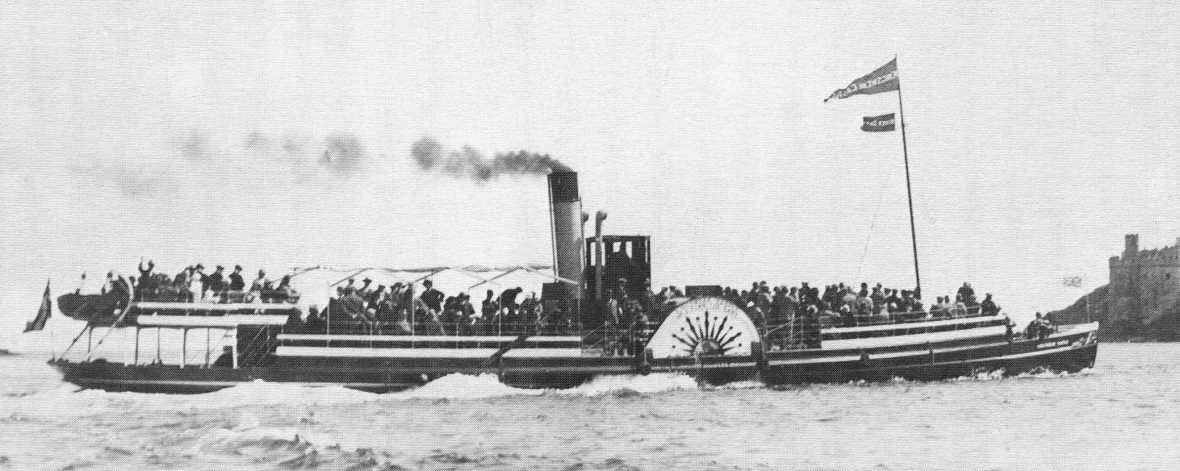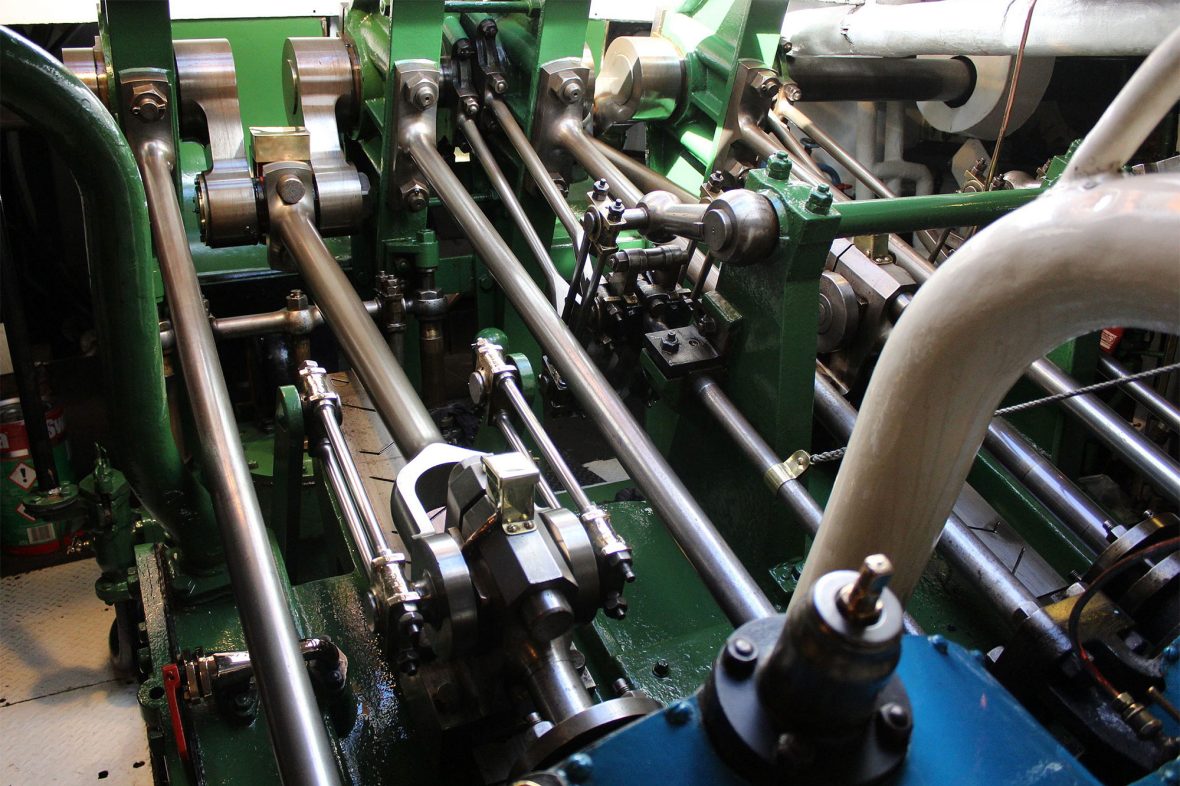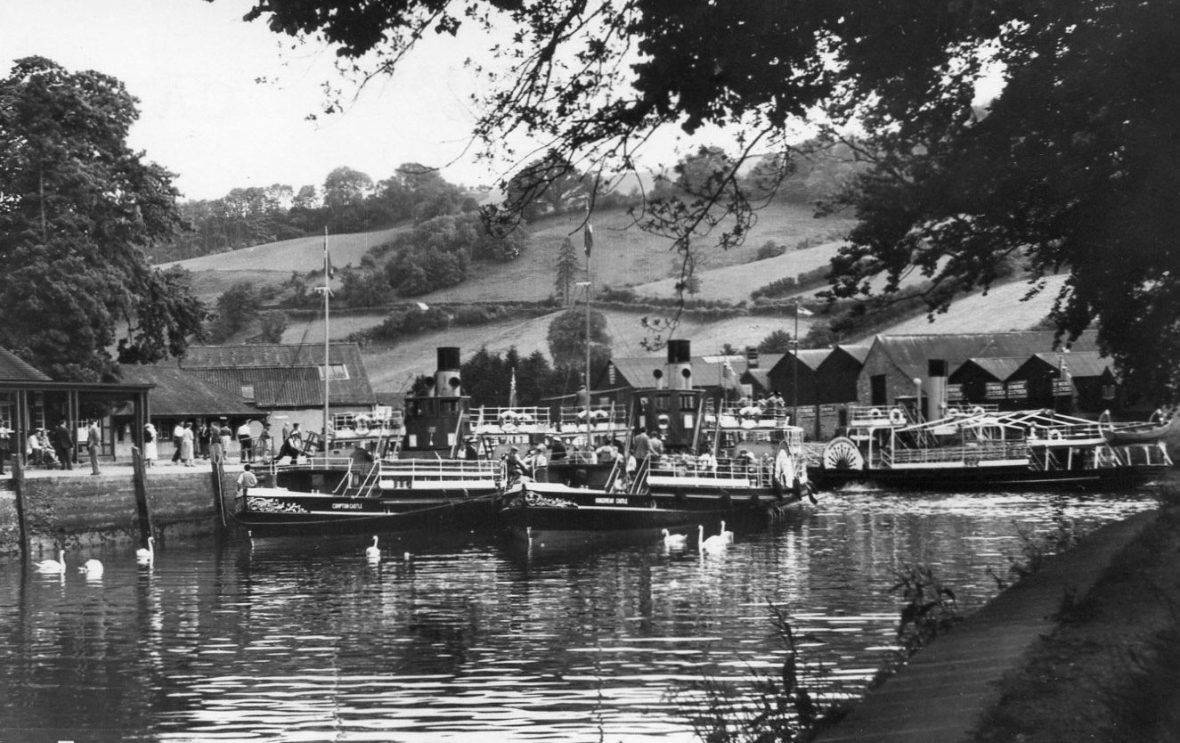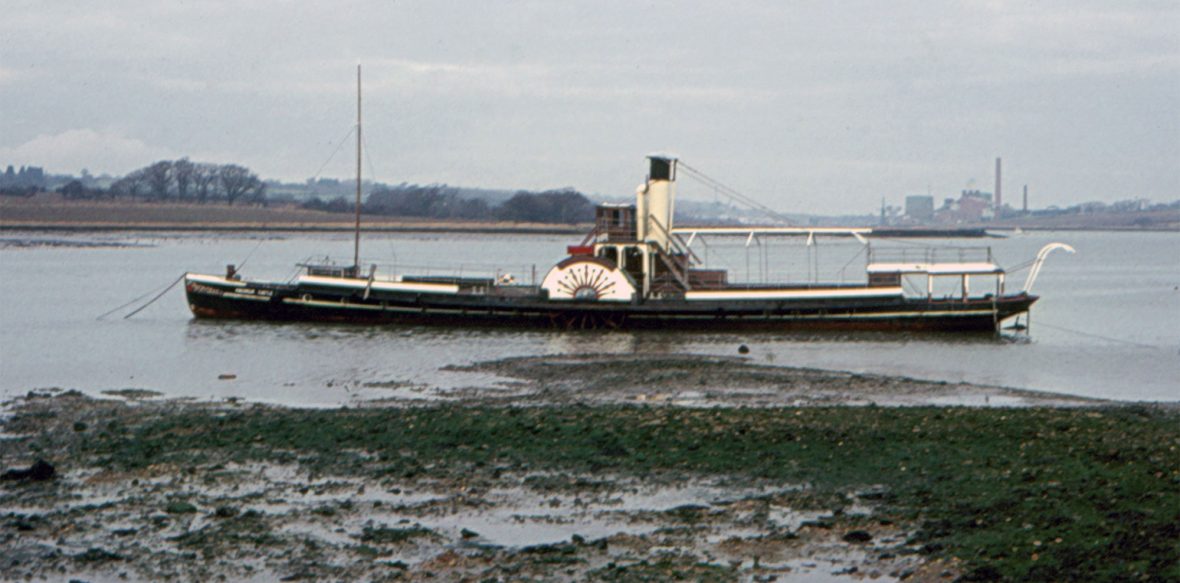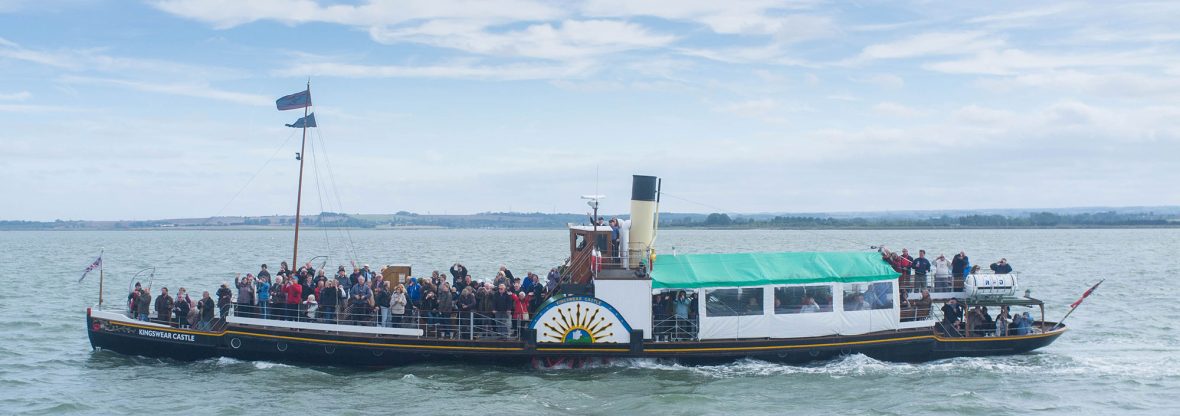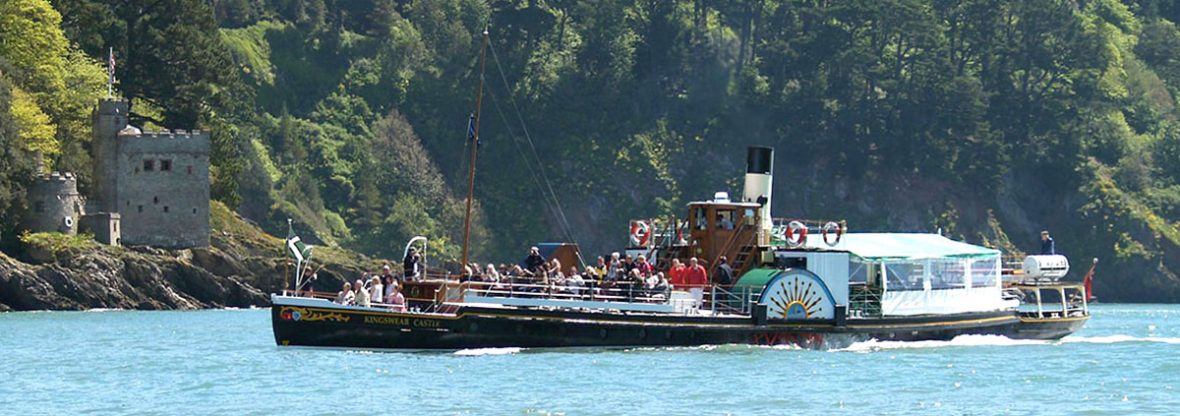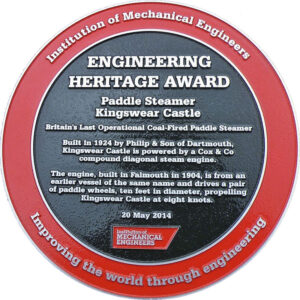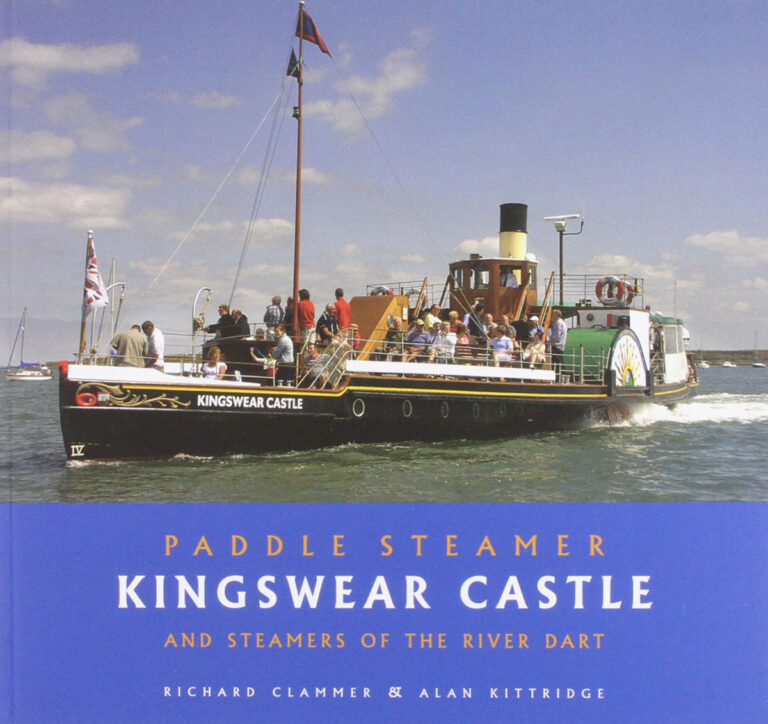Paddle Steamer Kingswear Castle, known affectionately by her initials KC, is Britain’s last coal burning river paddle steamer.
She was built by Philip & Son of Dartmouth, Devon in 1924 for the River Dart Steamboat Company Limited for service on the River Dart. The Trust purchased her with funds from the Paddle Steamer Preservation Society in 1967 and over a number of years restored her to her present-day condition. From 1985 until 2012 she operated on the rivers Medway and Thames, based at Chatham Historic Dockyard. In December 2012 Kingswear Castle returned to her home waters on the River Dart after an absence of 45 years. Kingswear Castle sails from Dartmouth and Totnes during the summer months. Her main sailings are 90-minute Dartmouth Harbour cruises but on selected days, subject to favourable tidal conditions, she steams up river to Totnes and back. More information on her sailings may be found here.
Kingswear Castle is listed in the National Historic Fleet by National Historic Ships UK.
The Beginning
Kingswear Castle was built in 1924 for service on the picturesque River Dart in Devon. She was built by Philip & Son of Dartmouth for the River Dart Steamboat Co Ltd. at a cost of £10,333 and was almost identical to her two older sisters; Compton Castle (built 1914) and Totnes Castle (built 1923). She was the last paddle steamer to be built for service on the Dart and a replacement for a previous Kingswear Castle built in 1904.
Recycled Engine
Kingswear Castle’s steam engine, a 130HP two-cylinder compound diagonal steam engine by Cox of Falmouth, is unusual in having both cylinders ahead of the paddle crankshaft, instead of astern of the shaft as is the more usual British practice. The engine dates from 1904, twenty years earlier than the rest of the ship. This is because her engine came from the earlier 1904 Kingswear Castle, the latter being relegated to being an isolation ship moored in Dartmouth Harbour. At the end of her useful life the 1904 ship was deliberately set on fire and abandoned to rot on the banks of the Dart opposite Sharpham House where her rusting hulk is still visible.
Service on the River Dart
From the 1920s until the 1960s, the trio of paddle steamers plied their trade on the River Dart between Dartmouth, or Kingswear and Totnes. At this time, Kingswear Castle was licensed to carry up to 400 passengers compared to a maximum of 235 today.
The work of the three paddlers continued uninterrupted until the outbreak of the Second World War in 1939. Kingswear Castle was initially used by the Admiralty as a depot ship at Dittisham but later, in 1941, she was chartered by the United States Navy for use as a liberty ship at Dartmouth. With the cessation of hostilities in 1945 she resumed her peacetime role. With changing holiday patterns and a decline in river traffic, 1965 was to be her final season, bringing her first 41 years of service on the Dart to an end. It was not to be her last.
From the 1920s until the 1960s, the trio of paddle steamers plied their trade on the River Dart between Dartmouth, or Kingswear and Totnes. At this time, Kingswear Castle was licensed to carry up to 400 passengers compared to a maximum of 235 today.
The work of the three paddlers continued uninterrupted until the outbreak of the Second World War in 1939. Kingswear Castle was initially used by the Admiralty as a depot ship at Dittisham but later, in 1941, she was chartered by the United States Navy for use as a liberty ship at Dartmouth. With the cessation of hostilities in 1945 she resumed her peacetime role. With changing holiday patterns and a decline in river traffic, 1965 was to be her final season, bringing her first 41 years of service on the Dart to an end. It was not to be her last.
Preservation
Kingswear Castle’s layup at Old Mill Creek did not last for long. Nick Knight from the Paddle Steamer Preservation Society surveyed the vessel with a view to the Society purchasing her. The River Dart Steamboat Company agreed to sell Kingswear Castle to the Society in the spring of 1967 for the sum of £600.
At the time the fledgling Society lacked the skills and deep pockets required to return her to operating condition. In the interim she was chartered Ridett Brothers on the Isle of Wight who were already using Paddle Steamer Medway Queen as a floating restaurant. In August 1967 she left Dartmouth and was towed to the River Medina to begin her new life in preservation though not yet restoration.
She steamed twice during her time at Medina, both in 1969 for the BBC television series “Bird’s Eye View” however her condition continued to deteriorate to the extent that the following year the PSPS seriously considered selling her for scrap.
Restoration
In June 1971 Kingswear Castle was moved to the River Medway where her restoration started slowly but in earnest, with many setbacks encountered that stretching the volunteers and purse-strings but the building momentum proved to be unstoppable. 1984 saw Kingswear Castle sail for the first time with passengers from Strood Pier, Rochester though her DTI certificate limited her initially to a maximum of 12. In May of the following year, with John Megoran appointed as Master and General Manager, and a certificate to carry up to 250 passengers, Kingswear Castle launched a full sailing programme from Thunderbolt Pier, Chatham, a little over twenty years after she had been withdrawn.
New Life on the Medway
For the next 27 years Kingswear Castle plied the waters of the Medway and old father Thames, cruising regularly as far as London, Southend and Whitstable. In that time, she carried many distinguished guests including HRH Prince Edward, Prime Minister Margaret Thatcher and none other than Neddie Seagoon himself, Sir Harry Secombe.
Whilst on the Medway much of the hull steelwork and wooden decks was replaced and new coal-fired boiler installed. Kingswear Castle by now was probably in better condition that when she left the shipyard of Philip & Son of Dartmouth in 1924. She deservedly won a number of awards including the National Steam Heritage Award in 1986 and the Scania Transport Trust Award in 1995. She also joined the National Historic Fleet.
Return to the Dart
It was always the intention of the Society to return Kingswear Castle to her native waters of the River Dart but her ongoing success and popularity on the Medway deferred the move from one year to the next. She finally returned home at the end of 2012 but not before one last hurrah, being select to join Queen Elizabeth II’s Diamond Jubilee Pageant on 3rd June 2012.
In 2014 the Institution of Mechanical Engineers (IMechE) presented Kingswear Castle with an Engineering Heritage Award as a mark of her unique place in British maritime history.
Kingswear Castle is owned by the Paddle Steamer Kingswear Castle Trust on behalf of the Paddle Steamer Preservation Society and is on long term charter to the Dartmouth Steam Railway and River Boat Company who operate her on the River Dart each summer.
Technical Specifications
Shipbuilder:
Philip & Son of Dartmouth, 1924
Engine builder:
Cox & Co. of Falmouth, 1904
Engine type:
130 HP (96 kW) two cylinder compound reciprocating steam
Boiler:
Scotch single furnace tube, 8 ft (2.43 m) diameter x 8 ft, coal-fired, working pressure 120 psi (8 bar)
Boiler maker:
Wellman Robey of Birmingham, 2000
Coal capacity:
4 tons (4,064 kg)
Length overall:
113 ft 8 ins (34.7 m)
Hull beam:
17 ft 6 ins (5.3 m)
Beam overall:
28 ft (8.5 m)
Paddle wheels:
10 ft (3 m) diameter, fixed wooden floats
Draught:
4 ft (1.2 m)
Speed:
8 knots (9 mph / 15 kph)
Port of Registry:
Dartmouth
MCA passenger certificates:
Class V (235 passengers) and Class VI (100 passengers)
Additional Reading
PS Kingswear Castle - A Personal Tribute
John Megoran was born in Weymouth and grew up watching the last days of Cosens’s paddle steamers in the 1960s. He returned Kingswear Castle to service in 1985 and for nearly 30 years ran the business on the Medway and Thames as well as sailing as her principal captain.
John wrote this book in 2017 and recounts the trials and tribulations of operating a paddle steamer on the Medway and the Thames.
For more information on this book and how to order, click here.
ISBN 978-1445665580. 96 pages, 180 illustrations. 165x234mm full colour soft back.
Paddle Steamer Kingswear Castle and Steamers of the River Dart
Richard Clammer and Alan Kittridge tell the story of Kingswear Castle: her origins through successive paddle steamers on the river Dart; the history of her first owner – the River Dart Steamboat Co Ltd; her preservation and operation in the south east; and her triumphant return to the river Dart.
The publisher will make a donation to the PSKCT Appeal for every copy sold.
For more information on this book and how to order, click here.
ISBN 978-0906294772. 76 pages, 116 illustrations. 210x196mm full colour soft back.

